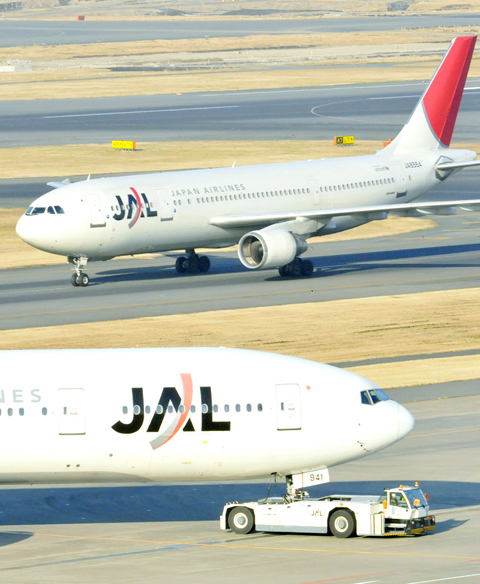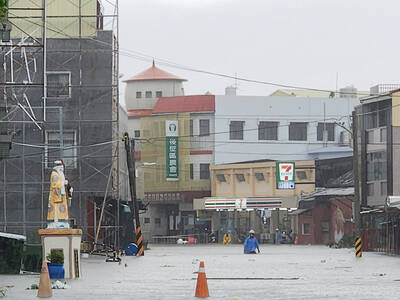Japan Airlines Corp (JAL) outlined restructuring plans yesterday that include cutting 30 percent of its global workforce and additional financing to keep flying after filing for bankruptcy protection in January.
JAL submitted the plans to the Tokyo District Court, the company said in a statement. The plans, in the works over recent months, also includes selling off subsidiaries and dropping unprofitable domestic and international routes.
The announcement culminates years of difficulty for Japan’s flagship carrier, battered by safety lapses, ballooning pension payments and the need to streamline its flight routes amid intensifying global competition.

PHOTO: AFP
The plan is being orchestrated as a government-backed bailout, under a group called the Enterprise Turnaround Initiative Corp (ETIC) of Japan.
About 16,000 jobs will be cut, although the job reductions will be partly the result of selling off subsidiaries, JAL said.
The plan also features a ¥520 billion (US$6.2 billion) debt waiver mainly from financial institutions and a ¥350 billion investment in JAL by ETIC, the company said.
The Japanese government and JAL officials are hopeful that the slimmed down carrier can return to profitability through its turnaround plan, including possibilities, such as going into the low-cost carrier business.
In related news, Japan’s factory output unexpectedly rose in July for the first time in two months as companies bolstered production of machinery, chemicals and paper despite signs of a slowing global economy.
Factory production climbed 0.3 percent from June, the Ministry of Economy, Trade and Industry’s monthly report released yesterday showed. The reading beat Kyodo news agency’s average market forecast for a 0.3 percent decline.
“Industrial production continues to show an upward movement although it has been pausing temporarily in part,” the ministry said in a cautious assessment.
The latest figures, however, did little to ease concerns about a strong yen and slowing growth in key markets like China and the US.
Japan’s economy barely grew in the second quarter, and policymakers are now scrambling to protect a faltering recovery. However, financial markets and economists were underwhelmed by both the central bank’s modest efforts on Monday to ease monetary policy and the government’s new ¥920 billion stimulus package.
A breakdown of yesterday’s data also reveals some worrisome details. Transport equipment, which makes up 17 percent of overall production, has fallen for three straight months.
The trend indicates that automakers are already scaling back production before the government’s subsidies for eco-friendly cars expire at the end of this month, said Junko Nishioka, chief economist at RBS Securities Japan.
“Deterioration of business sentiment is likely to cast a dark shadow on corporate activity,” she said.
The economy ministry said surveyed companies expect output to rise 1.6 percent last month and 0.2 percent this month. Shipments fell 0.1 percent, while inventory retreated 0.5 percent.

Rainfall is expected to become more widespread and persistent across central and southern Taiwan over the next few days, with the effects of the weather patterns becoming most prominent between last night and tomorrow, the Central Weather Administration (CWA) said yesterday. Independent meteorologist Daniel Wu (吳德榮) said that based on the latest forecast models of the combination of a low-pressure system and southwesterly winds, rainfall and flooding are expected to continue in central and southern Taiwan from today to Sunday. The CWA also warned of flash floods, thunder and lightning, and strong gusts in these areas, as well as landslides and fallen

WAITING GAME: The US has so far only offered a ‘best rate tariff,’ which officials assume is about 15 percent, the same as Japan, a person familiar with the matter said Taiwan and the US have completed “technical consultations” regarding tariffs and a finalized rate is expected to be released soon, Executive Yuan spokeswoman Michelle Lee (李慧芝) told a news conference yesterday, as a 90-day pause on US President Donald Trump’s “reciprocal” tariffs is set to expire today. The two countries have reached a “certain degree of consensus” on issues such as tariffs, nontariff trade barriers, trade facilitation, supply chain resilience and economic security, Lee said. They also discussed opportunities for cooperation, investment and procurement, she said. A joint statement is still being negotiated and would be released once the US government has made

SOUTH CHINA SEA? The Philippine president spoke of adding more classrooms and power plants, while skipping tensions with China over disputed areas Philippine President Ferdinand Marcos Jr yesterday blasted “useless and crumbling” flood control projects in a state of the nation address that focused on domestic issues after a months-long feud with his vice president. Addressing a joint session of congress after days of rain that left at least 31 dead, Marcos repeated his recent warning that the nation faced a climate change-driven “new normal,” while pledging to investigate publicly funded projects that had failed. “Let’s not pretend, the people know that these projects can breed corruption. Kickbacks ... for the boys,” he said, citing houses that were “swept away” by the floods. “Someone has

‘CRUDE’: The potential countermeasure is in response to South Africa renaming Taiwan’s representative offices and the insistence that it move out of Pretoria Taiwan is considering banning exports of semiconductors to South Africa after the latter unilaterally downgraded and changed the names of Taiwan’s two representative offices, the Ministry of Foreign Affairs (MOFA) said yesterday. On Monday last week, the South African Department of International Relations and Cooperation unilaterally released a statement saying that, as of April 1, the Taipei Liaison Offices in Pretoria and Cape Town had been renamed the “Taipei Commercial Office in Johannesburg” and the “Taipei Commercial Office in Cape Town.” Citing UN General Assembly Resolution 2758, it said that South Africa “recognizes the People’s Republic of China (PRC) as the sole